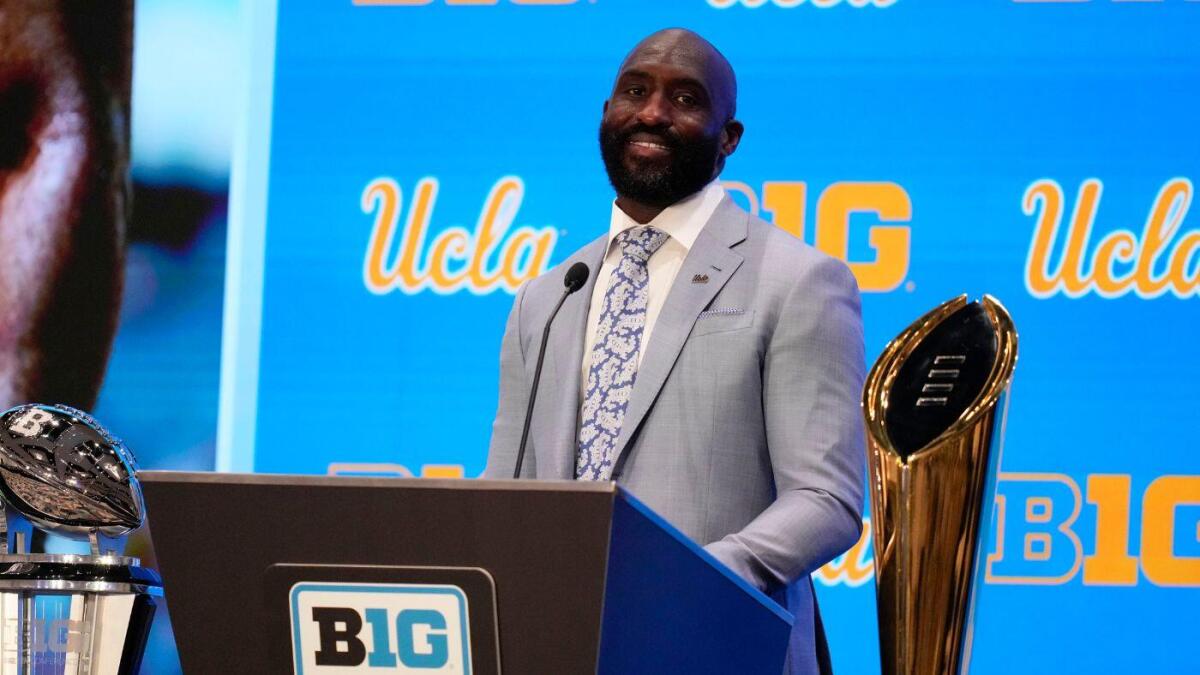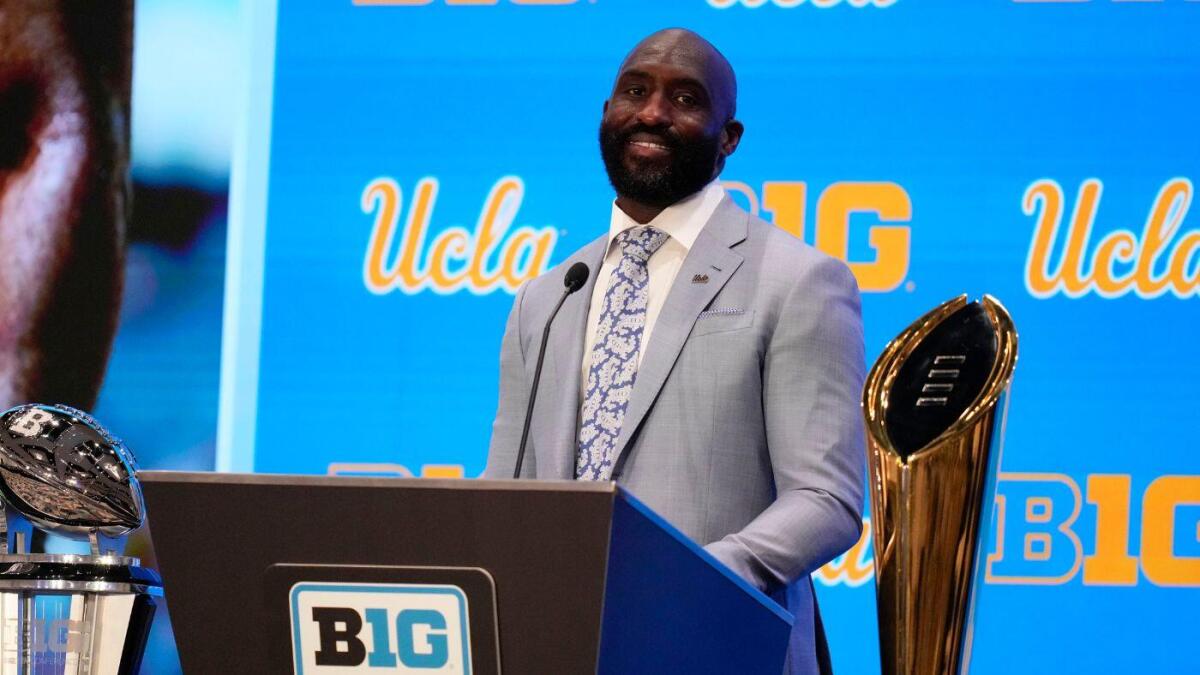The Evolution of Leadership: DeShaun Foster’s Media Day Transformation
A Moment That Captured Attention
The sports world is no stranger to viral moments, but few have been as instantly memorable as DeShaun Foster’s initial appearance at Big Ten Media Days. As the newly appointed head coach of the UCLA Bruins, Foster stepped onto the stage with the weight of expectations pressing down on him. What followed was a brief but impactful moment of silence—a pause that, in the fast-paced world of sports media, felt like an eternity. The silence was not just a moment of hesitation; it was a moment of vulnerability that quickly became a defining image of Foster’s early tenure.
The incident was dissected and discussed across social media platforms, with some questioning Foster’s preparedness for the role. Reports suggested he had not prepared notes, contributing to the awkwardness. Yet, in the midst of the criticism, there was something undeniably human about the moment. In an era where public figures are often carefully crafted and media-trained, Foster’s stumble felt surprisingly real. It was a reminder that even those in positions of leadership are not immune to moments of uncertainty and pressure.
The Power of Reflection and Growth
The year following the initial media day stumble was a period of significant growth for Foster. It provided him with an opportunity to reflect on the experience, learn from it, and develop strategies for future public appearances. More importantly, it allowed him to focus on building his program at UCLA. The team was preparing to enter a new era in the Big Ten Conference, and Foster had the responsibility of shaping the team’s identity and culture.
During this time, Foster likely worked on improving his communication skills, perhaps with the assistance of media training professionals. He also focused on developing a clear and concise message about his vision for the UCLA football program. The goal was to transform the initial negative impression into a positive narrative of growth and resilience. This period of reflection and preparation was crucial, as it laid the foundation for Foster’s eventual redemption.
The Art of Redemption
Fast forward to the following year’s Big Ten Media Days, and Foster returned to the same stage, this time armed with experience and a renewed sense of confidence. Instead of shying away from the previous year’s mishap, he addressed it directly. By referencing the viral gaffe, Foster demonstrated a sense of humor and self-awareness that resonated with the audience. He acknowledged the mistake, showed he had learned from it, and used it as a springboard to showcase his growth as a leader.
This act of embracing his past stumble was a powerful move. It signaled authenticity and a willingness to be transparent, qualities that are increasingly valued in leadership. Rather than trying to erase the memory of the awkward moment, Foster owned it and used it to connect with the audience on a more personal level. This approach not only showcased his growth but also highlighted his ability to turn a potential setback into an opportunity for connection.
The Value of Authenticity in Leadership
Foster’s journey highlights the importance of authenticity in leadership. In today’s world, people are often skeptical of polished and overly produced public figures. They crave genuine connection and appreciate leaders who are willing to show their human side. By acknowledging his mistake and demonstrating how he had learned from it, Foster presented himself as a relatable and authentic leader.
Authenticity is not about being perfect; it’s about being real. It’s about acknowledging one’s strengths and weaknesses and being true to one’s values. When leaders are authentic, they build trust and inspire others to be their best selves. Foster’s ability to turn a moment of vulnerability into an opportunity for growth demonstrates the power of authenticity in building leadership credibility.
Lessons for Leaders in All Fields
DeShaun Foster’s experience at Big Ten Media Days offers valuable lessons for leaders in all fields, not just sports. The ability to navigate public scrutiny, learn from mistakes, and embrace authenticity are essential qualities for anyone in a leadership position.
Here are some key takeaways:
- Embrace Vulnerability: Don’t be afraid to show your human side. Vulnerability can be a strength, not a weakness.
- Learn from Mistakes: Everyone makes mistakes. The key is to learn from them and use them as opportunities for growth.
- Be Authentic: Be true to yourself and your values. People are more likely to trust and respect leaders who are genuine.
- Communicate Effectively: Develop clear and concise messaging to communicate your vision and goals.
- Turn Challenges into Opportunities: Use challenges as opportunities to demonstrate resilience and leadership.
Foster’s story serves as a reminder that leadership is not about perfection; it’s about progress. It’s about learning, growing, and adapting to challenges along the way.
Building a Legacy at UCLA
DeShaun Foster’s journey from a viral pause to a moment of redemption has set the stage for a new chapter in his coaching career at UCLA. He has demonstrated the ability to learn from his mistakes, embrace authenticity, and connect with people on a personal level. As he leads the Bruins into the Big Ten Conference, he will undoubtedly face new challenges and opportunities. However, his experience at Big Ten Media Days has prepared him to navigate these challenges with confidence and resilience.
Foster’s legacy at UCLA will not be defined by a single moment, but by his ability to build a winning program, develop his players, and inspire those around him. His journey so far suggests that he has the potential to achieve great things and leave a lasting impact on the UCLA football program.
The Power of Perspective
DeShaun Foster’s story powerfully illustrates the potential to reframe perceived failure into a catalyst for growth and connection. What began as an awkward and widely publicized stumble transformed into a moment of relatability, demonstrating that even those in leadership positions are not immune to human fallibility. This narrative underscores the importance of perspective, highlighting how setbacks, when approached with humility and a willingness to learn, can pave the way for genuine leadership and lasting impact. It encourages us to view imperfection not as a barrier, but as an invitation to build stronger, more authentic connections with others.












